

 The South African
The South African
My copy turned out to contain two stories. The first recounted the exploits of the South African Brigade in Europe, but the other, which I wish to share here, concerns newspaper clippings, pressed flowers and neatly written notations on its hand-cut pages.
The notations are numerous and scattered throughout the book, but the majority were found in Chapter VI: “The Third Battle of Ypres”.
The first notation refers to a Diary in the possession of the notator.
A few pages later Buchan refers to a Sergeant Frohbus who ‘headed an attack, through our own barrage, against a large ‘pill box‘ immediately on [his] front‘. Against the Sergeant's name a second notation reads “Emil's friend, and he who saw both my darling and Alfy fall. He lost his right arm in that attack”.
A third notation refers to “Perth Cemetery, China Wall, Zillebeke, 3¼ miles east of Ypres. Plot 3, Row K, Grave 14”.
This information led me, via the Commonwealth Graves Commission (CWGC) website, to identify it as referring to a Private Emil Bawden Volbrecht, age 19, of ‘A’ Company, 1st South African Regiment, the son of Charles Ernest and Sarah Johanna Volbrecht of 10 Angle St, Beach Hill, East London.
The South African Military Archive in Irene has a very thin file for Private Volbrecht - not especially surprisng since he was dead a mere seven months after being taken on strength in Potchefstroom on 16 Feb. 1917. His attestation papers tell that he was 5ft. 10 inches (1,78 metres) tall, weighed 142lbs (64,5kg). They list his occupation as “Draper” and his religion as “Wesleyan”.
From Potchefstroom he embarked at Cape Town on His Majesty's Transport(HMT) Galway Castle on 10 March 1917 for England and was posted to Woking in Surrey for training. He was granted leave from 03 to 06 June and being only 75 minutes from London it is likely Emil would have spent his leave there with his pals. It is recorded that he joined the ‘battalion in the Field’ on 03 July and was posted to ‘B’ Company. Later, he transferred to ‘A’ Company.
Private Volbrecht’s service file is ‘silent’ on his time with the battalion: the next entry is the record of his death. In view of this approximate three-month gap in his military service file we are fortunate that Peter Digby in Pyramids and Poppies dedicates an entire chapter to this period in the Brigade's history, under the heading “The three bob-a-day men”. The Volbrechts, of course, would have had some knowledge of this period from letters sent home and from their son's Diary.
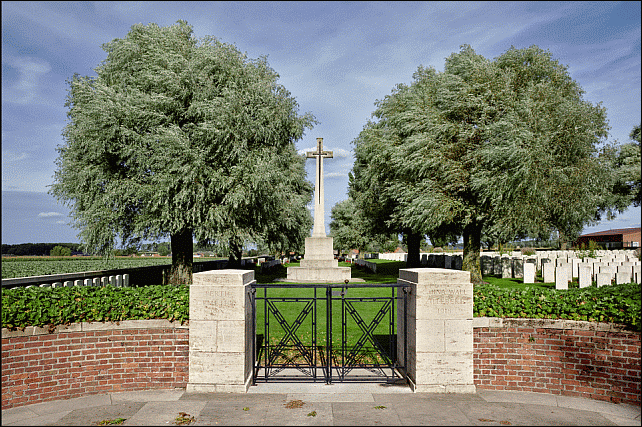
Entrance to Perth Cemetery aka China Wall
cemetery near Iepers in Belgium
On the day that Private Volbrecht was posted the S A Brigade was at rest in Divisional reserve outside Arras at a place called Y Huts. However, to refer to the unit as a Brigade was a misnomer. Following the Battle of Arras and what Digby refers to as the Fampoux fiasco, the Brigade was a shadow of its former self and had been broken up into composite Battalions. Private Volbrecht was one of the 1 448 men sent from the Brigade Depot between April and the end of June, to bring the various units up to strength.
Four days after his posting, on 07 July, the Brigade moved to a new training area between Simencourt and Berneville in the Somme district. This new posting, it is recorded, offered far more pleasant conditions than those experienced at Y Huts.
Digby writes that the new recruits were received with mixed feelings by the ‘old sweats’ who considered their sole motivation for enlisting was a recent increase in pay from one shilling a day to three.
During this period a Company of the 1st South African Infantry were detached for burial duties behind High and Mametz Woods, an area that had experienced some of the most bitter and prolonged fighting during the Somme offensive in 1916. Whether Emil was part of this detailis not known, but since it was a detachment from his own Regiment it is unlikely he was spared any of the gory details, even if only as a second-hand experience.
On 27 July the Brigade moved up to thefront at Trescault on the Canal du Nord. It was apparently a quiet sector. Here the South Africans remained until mid-September when, together with the rest of the Ninth (Scottish) Division, they were shifted to Brandhoek (approximately 9km from Ypres), arriving on 14 September. The South African Brigade were sent to Eyre Camp near Poperinghe, reaching there on the 15th.
The 3rd Battle of Ypres had been raging since the end of July. After the encouraging capture of the Messines-Wytschaete Ridge progress had bogged down (with further action suspended) in the morass resulting from heavy, unseasonal rain and the destruction of the fragile Ypres drainage system by incessant artillery pounding. By the time Ninth Scottish Division moved up the weather had improved, and the ground was now considered sufficiently dry for the offensive to resume.
The Ninth was attached to Gough’s Fifth Army and their objective was the high ground east of the Ypres Salient. Haig believed these hills, once cleared, would enable him to move against the Belgian coast.
Confronting the Ninth was a German defensive system of machine gun-equipped pill boxes, echeloned in-depth. These pillboxes were small concrete forts housing from 8 to 40 men, difficult for artillery to target (projecting only a few feet above ground) and impenetrable to all but the heaviest shells. Previous attempts by the 5th Army to clear this system had failed, with many Fifth Army Brigades sacrificed in the attempt. The Ninth's would be the fourth attack against this objective.
Major General Tim Lukin, GOC of the 9th Scottish Division, had studied this pillbox defensive system and devised a strategy that would allow his Division to both take and hold their objectives. Lukin was aware of prevailing German defensive tactics, consisting essentially of a thinly held, elastic, front line system of defence with stronger second and third lines behind, and with counter-attack troops readily available to take back any lost ground before the attacking force had time to consolidate their gains.
Lukin and his Divisional Commanders now made two tactical decisions, both of which were crucial for a successful attack.
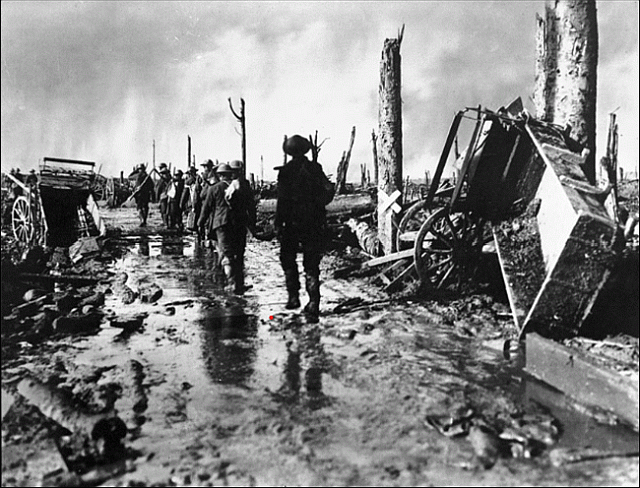
Going forward in the Ypres salient
Arguably the more significant of these two decisions was the requirement that the first attack wave should eliminate the pill boxes, allowing the second wave to leapfrog past them to engage the next objective.
The second tactical decision emanated from the first. It was recognized that to eliminate the pill boxes the attacking force needed to get close in order to surround and neutralize them. To protect the attackers from the murderous impact of machine gun fire, it was decided to employ a creeping artillery barrage to mask the advance. High explosive shells (as opposed to the more commonly used shrapnel) were to be used, as it was considered their bursts were far easier for advancing troops to see and therefore follow closely.
Whilst at Eyre Camp the South African Brigade received intense training with all ranks briefed using clay models of the ground over which they would attack. They left Eyre Camp on the afternoon of Saturday the 17th and were transported in open railway trucks from Poperinghe to Ypres.
The nights of 17th and 18th September were used to reconnoitre the routes the troops were to follow from the reserve trenches to their assembly areas. The routes were marked out using sign boards and white tapes, with guides to accompany and direct the troops. Considering it was to be undertaken over duckboards across a featureless, devastated landscape with the danger of enemy shelling ever-present during the approach, the assembly process was viewed with considerable apprehension.
In the event, the approach (at 22:00on the 19th) went well and is brilliantly described by Second Lt Geoffrey Lawrence of the 1st SAI (Digby p. 227). He describes the troops moving up through Ypres and how by 03:00 he was able to report them as in position. Rum was issued to each man and by 05:00 (zero hour) all was ready.(1) The rain had stopped by 04:00, and it would not rain again until the 22nd, the day on which the Brigade was relieved.
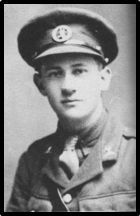
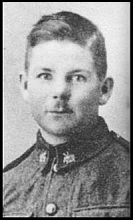
Geoffrey Lawrence and George Warwick
The front allocated to the Ninth Division was on the Frezenberg Ridge, approximately 1,8 km north of the Ypres-Menin Road. It was a two-Brigade front, with the South African Brigade on theleft and the 27th Brigade to their right, the 26th Brigade being held in reserve. The South African attack was led by 4th SAI (with 2nd SAI in support) and to their immediate right 3rd SAI (supported by 1st SAI). The 9th Division was expected to achieve three objectives. The first (scheduled to be reached by 07:00) was the line of the (by now almost unrecognisable) Steenbeek stream. Shortly after the start of the British artillery barrage the Germans responded in kind, shelling the old front line so that it became necessary for the support Regiments to be brought up closer to those attacking.
Corporal George Warwick of 4th SAI states in Band of Brothers that “We attacked in file, my nine men following behind me”. This detail is significant. Attacking in file (as opposed to in lines, or ranks) was another deliberate tactic employed by the Division both to try to minimise the ‘kill rate' of pillbox machine gun fire and also to guard against the attacking troops following up too closely to their own barrage.
Inevitably, both 3rd and 4th SAI were met with a combination of machine gun and shell fire. Warwick noted that it was impossible to see where the machine guns were hitting or traversing because the soggy ground absorbed their bullets effortlessly, without showing any tell-tale spurts of earth. It was simply a matter of luck whether a file of men was caught or missed by a machinegun burst. (Incidentally, Corporal Warwick was injured and permanently disabled during this attack.)
On the right, the three Companies of 3rd SAI under the command of Lt-Colonel Thackeray C.M.G., made a successful attack. They cleared all the strong points in their path including ‘Vampir’ (their main objective), ‘Bit Works’, and various dug-outs north of ‘Potsdam’ and to the South of ‘Borry Farm’. Digby notes “they had completely surprised the Germans by following hot on the heels of the barrage, and in many cases through it, so the enemy could be bombed, shot, bayoneted or captured in their pill boxes before they knew what was upon them”.
Indeed, so fast was the 3rd SAI advance that they now started to suffer casualties from enfilade machine gun fire from their immediate right, from the Potsdam Redoubt. This, a 27th Brigade objective, consisted of three separate pill boxes. It illustrated a problem which had been anticipated during the planning phase. The directive that the attacking units leading the advance should eliminate all enemy defensive obstacles before moving on meant that if an attack was stalled in a particular sector, it would have a knock-on effect on neighbouring units, potentially bringing the entire advance to a halt. This anticipation had suddenly become a reality, putting atrisk the attack on the second objective.
Accordingly, Lieutenant Colonel Heal, OC 1st SAI, ordered 3 companies of 3rd SAI together with a detachment from 1st SAI to take Potsdam and to form a defensive flank. This they achieved after the attack was resumed at 06:55.
After consultation between Brigadier Generals Dawson and Maxwell VC (27th Brigade) it was decided that the South Africans would extend their right flank. Two attacks against pill box installations were then mounted in quick succession. The first was led by 2nd Lieutenant Geoffrey Lawrence with half a platoon of 1st SAI. The second, at 06:50 (shortly before the scheduled advance on the second objective) was led by Sergeant Frohbus against a large pillbox structure, with men of the 1st and 3rd SAI. They advanced through the British barrage (Digby, p.239) this is the attack in which Frohbus reportedly lost his right arm.
We cannot be sure when 'Emil and Alfy fell’ but it was almost certainly at some time between the attack on the Potsdam Redoubt and the moment when Sergeant Frohbus was wounded. Until now 1st SAI had been only partially engaged, and whilst inevitably suffering some casualties these were probably comparatively few in number. It is therefore reasonable to suggest that Emil and Alfy were killed shortly after the Frohbus advance commenced. Indeed, it is possible that they became casualties of friendly shell fire while advancing through their own barrage.
So far as the remainder of the Brigade’s attack on that day is concerned, Buchan wrote that “the advance on the 20th of September was without doubt the most successful achievement to date in the campaign”. However, success (in what came to be called the Battle of Menin Road) came at a most heavy price. The Brigade had gone into action on the night of the 19th/20th with 91 officers and 2 485 other ranks. When they were relieved they had sustained a 49% casualty rate. 1st SAI's casualty rate was 51%.
Emil's file at the Military Archive includes a Casualty Report dated 06/10/1917 and a note that Mrs Volbrecht was notified of her son’s death on 10/10/1917.
Private Volbrecht was buried in the field and whilst his personal possessions would have been returned to the Volbrechts (Emil’s diary for instance) the family must have agonized over what had happened to their son during his final moments. Certainly they would have been anxious to know that he had not suffered. Emil's remains were only recovered from the field two years later, in September 1919. During this time - and afterwards as well of course - Emil's family would have been desperate to speak with someone ’on the spot’ at the time of his death - perhaps even witness to it.
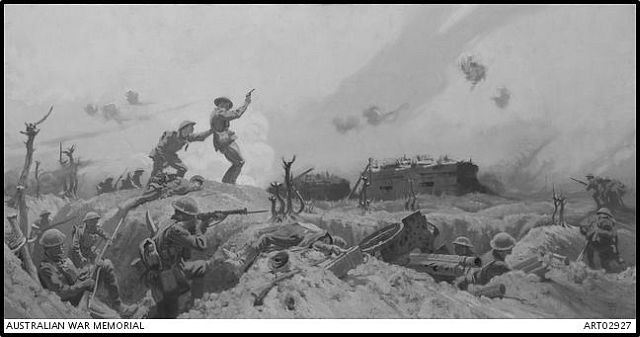
Australian War Museum artwork of attack on German pillbox
It is almost certain the Volbrechts met with Sergeant Frohbus. Mrs Volbrecht’s notations specifically refer to him as ’Emil’s friend’ and ’he’ who saw ’my darling and Alfy fall’. There is also very strong evidence that Sergeant Frohbus, like the Volbrecht's, was an East London resident: a Major Cyril Frohbus (Ret.) was an East London MOTH.
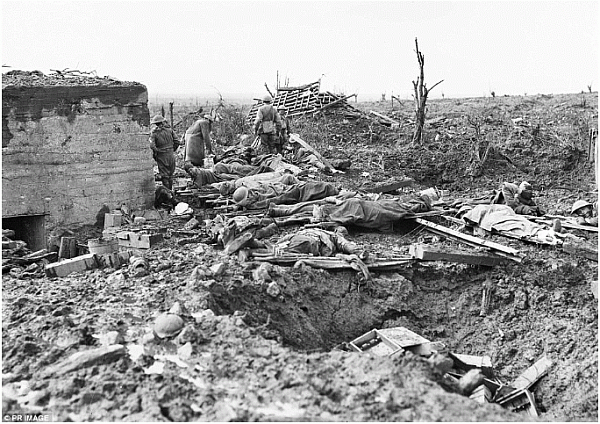
First aid post behind Captured German pill-box
But who was Alfy? Undoubtedly, he had been a friend of Emil’s, but Mrs Volbrecht's personal notes hint that he may have been known to the family also. When I bought Buchan's book very little may have been known to the family also. When I bought Buchan's book very little online information existed. Now, even a cursory internet searchof 'Emil Bawden Volbrecht’ brings up numerous links. A later relative recently updated the Volbrecht family history and details of Emil’s parents and siblings are fairly easily found. Another web page, a-street-near-you.org, details Private Volbrecht’s death, burial and next of kin records (in the same format as that providedby the CWGC).
It also includes a ’possible matches’ resource which shows details of other deceased servicemen sharing similar records. This database links Emil with a James Alfred Clark, also from East London, revealing they both served in 'A’ Company, 1st SAI, both were killed on the same day, and both are buried at Perth (China Wall) Cemetery. Their respective cemetery memorial references are III-K-4 and IIIK-5, meaning they are buried next to each other. James Alfred Clark’s service number is 11807, Emil's is 11806, indicating they likely joined up together.
James Alfred’s father was also a James, so it is clear why the son would have been known as 'Alfy’. Another likely assumption is that Emil, posted to 'B’ Company when joining the Battalion 'in the Field’, would have requested a transfer to 'A’ Company, to serve alongside his friend.
The CWGC Concentration of Graves Report suggests that both boys’ remains were exhumed from the field at the same time and from similar map references (Emil from D.26.a.4.1 and Alfy from D.26.a.4.6). Alfy's body was identified immediately from belongings found on his body, while Emil's was initially listed as an Unknown Soldier. Later, what the CWGC describes as a ’numeral disc’ was found on his remains, allowing identity to be established.
Following exhumation, the CWGC communicated with both families; initially to inform them of the recovery and identification of their remains. Initially, neither were buried with an individual marker or cross, but markers had been erected by September 1919.
Both families elected to have personal inscriptions included on their son's headstones. The Volbrechts chose an extract from the Song of Solomon: “Until the day breaks and the shadows flee away”. Alfy’s inscription reads “He heard the call of duty and answered”. There are three 1st SAI graves in the Perth (China Wall) cemetery, all lying next to one another, the third grave commemorating a Private Gibb from Natal.
The Volbrechts were almost certainly in possession of Buchan’s book by the time Emil was buried (14/09/1920), or soon after. They transcribed into it details of his memorial reference, though they wrote 'Grave 14’, while the CWGC entry refers to 'Grave 4’. The Volbrecht notation seems be either a transcription error or a misreading of the CWGC record.
As tragic as this story is, and as heartbreaking as it must have been for the Volbrecht and Clark families to learn of their sons’ deaths, it must have been of some comfort to them to know that the two friends were together at the very end. Emil and Alfy were lifelong friends who not only enlisted together but also contrived to stick together throughout. Whether by accident or design matters not, they are together still.
On the fifth anniversary of the signing of the Armistice the unveiling of East London's War Memorial took place, fittingly performed by Sir Henry Tim Lukin. During the ceremony the Roll of Honour was read out and the names of EB Volbrecht and JA Clark called. The Daily Dispatch reporter recorded it was a day of lowering sky and with occasional showers, and that “things were somewhat uncomfortable”, evidently unconscious of his words' irony. I feel sure the irony did not escape many of the Daily Dispatch readers however, least of all the Volbrechts and Clarks, for tucked into the very chapter where Mrs Volbrecht had written 'this is the day my darling fell’ is a newspaper clipping with the following words underlined '.I advise any man to go and stand on the top of the Passchendaele Ridge and look on his right hand and left, and then back across the dreadful plain to Ypres and to ask himself whether a three and a half month battle should have been fought on such ground’.
Authors Note:
This piece is intended as a human-interest piece and not as academic research. For the latter I have relied heavily on Peter Digby's Pyramids and Poppies (especially his description of the Battle of Menin Road). I am therefore indebted to the late Mr Digby's research, for without it the telling of this story would not have been possible.
With thanks to:
Mrs Glenn Hartwig (Assistant Reference Librarian, Buffalo City Libraries) for her
most kind assistance and for the Daily Dispatch article detailing the unveiling of
the East London War Memorial.
Dr. Anne Samson for her gracious assistance and for introducing me to the National Archive in Irene.
Mr Malcolm Kinghorn for his reading, editing and encouragement of this piece.
Finally, to Emil's parents (Charles and Sarah Volbrecht) whose book found its way to me and whose notations are the basis of my story. I hope I have done justice to thememory of their son.
References:
The National Archive, Irene, Pretoria (for Private Volbrecht's Military Service records.)
Buchan, J: The South African Forces in Europe, Nelson, 1920
(especially Chapter VI, .The Third Battleof Ypres.)
Digby, PKA: Pyramids and Poppies: The 1st South African Infantry Brigade in Libya, France and Flanders 1915-1919, Ashanti Publishing, 1993 (especially Chapters 20-22)
Warwick, GW: We Band of Brothers, Howard Timmins 1962 (especially
Chapter 20, "The Third Battle of Ypres (Menin Road) (20th September 1917)".
Commonwealth War Graves Commission . www.cwgc.org
A Street Near You www.astreetnearyou.org
Note
1 Note that while zero hour is recorded as 05:00, Buchan states that the advance commenced at 06:20, with 05:00 being the artillery barrage start time. In any event, it was “not yet daylight" when they started out. (Warwick)
About the Author:
Andrew is a recently retired Life Insurance Company Executive. He describes himself as a 'back of envelope' amateur historian with a particular interest in Great War and Anglo-Zulu War history. His best holidays have been spent walking localand Western Front battlefields and cemeteries.
Return to Journal Index OR Society's Home page
South African Military History Society / scribe@samilitaryhistory.org